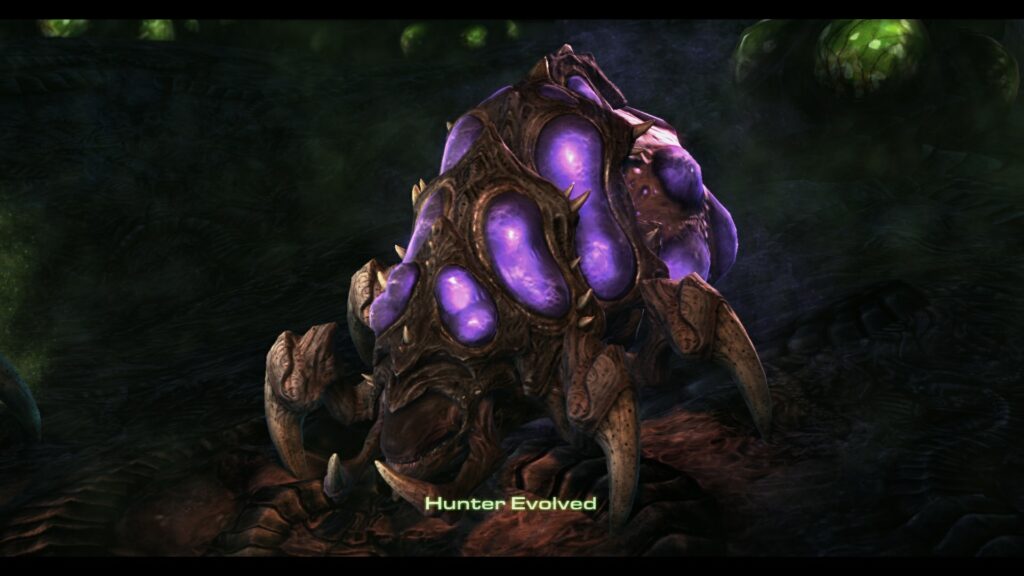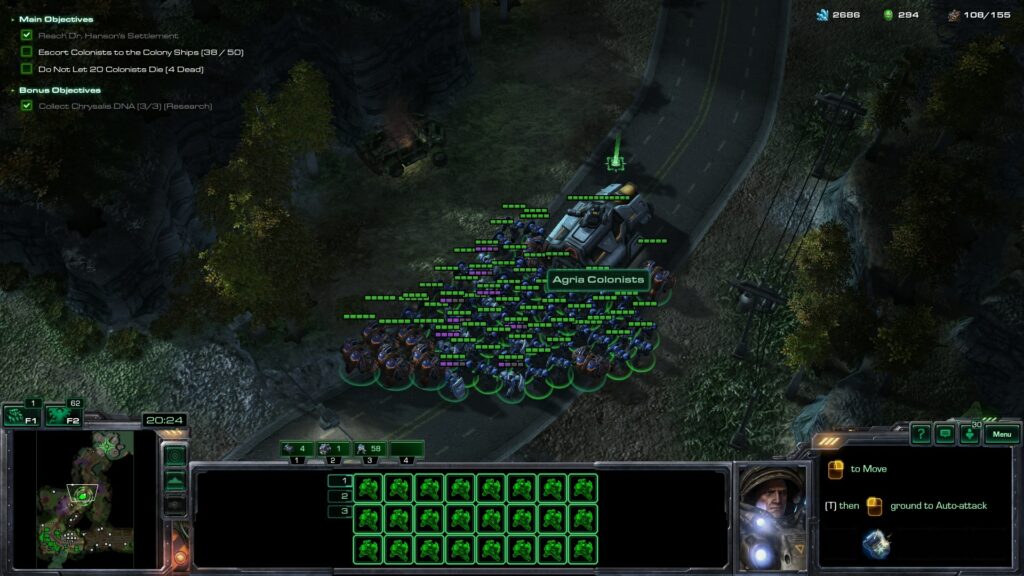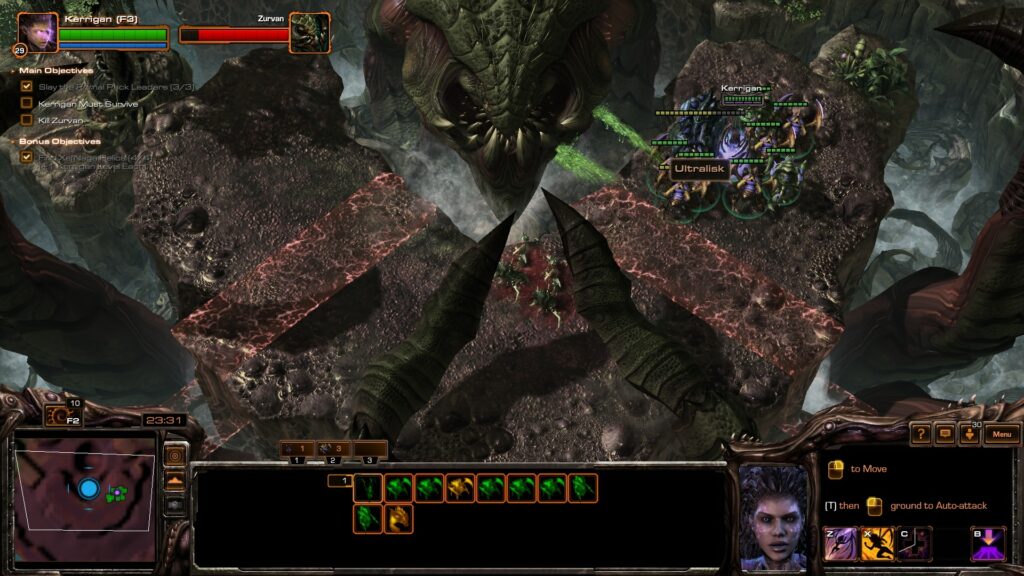It would stand to reason that if I played through all the Command & Conquer games while researching my RTS book, I would have to check out the other “tiny” competitor of StarCraft. While I didn’t have the time to go through the entirety of StarCraft 1, I did decide to play through the sequel for both Terran and Zerg on the highest difficulty. Given this is the first time I’m actively analyzing StarCraft, it’s amazing to look at what would become one of Blizzard‘s best games at its peak and how little other studios learned from it, even EA LA.
Three For the Price of Three
While there may only be technically 2 StarCraft games compared to the 7 main games of Command & Conquer, fans definitely got their money’s worth with StarCraft 2. Even though players had to buy access to all three campaigns, each campaign/expansion was its own full-length game (more on that in a second). This is different from Command & Conquer and other multifaction games where the total of missions are split between each faction. Besides getting triple dipping for StarCraft 2, it did allow Blizzard to fully embellish each campaign way beyond what any RTS designer did or has done since.
Each campaign has an entire area to explore for lore and easter eggs, cinematic and in-game cutscenes, and more variety of missions than other RTS, even the Command & Conquer games. What puts it above and beyond is how the developers just said “screw it” to trying to have to balance between single and multiplayer modes.
Separately Single
StarCraft 2 followed in the footsteps of what would become the Mortal Kombat revival in that the developers realized that the people who play their game for single-player content are completely different than the ones looking for a competitive game and vice versa. Instead of trying to create content that would act as a bridge between the two, the design leaned all in on creating a 100% unique single-player experience.

unique units and upgrades give the single player campaigns far more life than any other RTS out there (source: Author).
Besides the mission design that I’ll talk about next, all three factions are given unique upgrades, units, and progression that are completely removed in the multiplayer matches. While some tech upgrades and bonuses can be researched, a lot of the spicier units and features are removed from multiplayer. At first, this sounds like a bad idea — why would you remove cool stuff in one mode from another? But the reason is that it would completely throw Blizzard’s trademark balance out the window. Many of the advanced upgrades are explicitly designed to break the traditional rules of balance — Terran examples include allowing SCVs to be built two at a time and multiple ones working on a single construction. Anyone who has played or watched professional games knows that being able to build your base faster is a monumentally huge advantage in a competitive game.
The Zerg get powerful mutations and having Kerrigan as a hero unit for most of the campaign. I like how the developers didn’t just create one unique form of the campaign, but three. Since the player can also pick and choose which upgrades to go after, it provides a rare example of replayability built into the design of an RTS.
These features also tie into Blizzard’s mission design and how it stands unique among other RTS to this day.
A Scripted Strategy
Perhaps the biggest difference between Blizzard’s style and Westwood/EA LA’s take on RTS design is the approach and design of the missions. In Command & Conquer, almost every base-building mission involves the player destroying the enemy’s base. The enemy will have an advantage but is still playing the game to some extent to take on the player.
With StarCraft 2, and of course, the earlier games as well, the player and the AI are on two different planets in terms of their goals on a map. Blizzard focuses on unique one-off missions, where most of the objectives typically don’t involve destroying the enemy’s base. And the ones that do have very different conditions compared to other games.

mission variety is nice, but it does strain against the scripted nature of the gameplay. (Source: Author)
In my retrospective piece on Command & Conquer, I said that the earlier games could be treated as RTS puzzles, but those pale in comparison to the structure that Blizzard laid out in StarCraft 2. Because each mission is also used to unlock a new unit, a mission pulls double duty of challenging the player and integrating that unit into the player’s repertoire.
To wit, every mission has a unique condition/s that the player must abide by, and this is further expanded by having the new unit be “the star” of the map. The challenge is that the player must figure out how to achieve their goal given the specific objectives and behavior of the enemy. In one map, the player must rush out and destroy buildings by day that spawn infected by night; this could have also been the inspiration for They are Billions. Normal units are not fast enough to cover the map and deal with them, but the mission introduces hellions to the mix.
Playing them on brutal difficulty also highlights just how much map and unit knowledge are key to winning. If you try to play these maps like you would a competitive game of StarCraft 2, you are going to lose. A big reason for this is the time and resource constraints that affect a lot of the map conditions. Tier 3 units are slow to build up towards, let alone get enough to make an army out of. Many maps have an explicit time limit on how long you have to complete an objective or before things get worse for the player. On a later Terran map, the player has to defend a giant laser from waves of Protoss units. Given the frequency and number of attacks, you don’t have the luxury to just tech up, and on the highest difficulty you may not even have enough resources to build a large enough army. In an even further one, you are being chased by a literal wall of fire, so good luck with trying to get a base set up somewhere.
But now it’s time to talk about the eternal question — which one holds up better today?
Strategy vs. Strategy
Looking at the two designs and it really comes down to two completely different schools of thought for what mission and unit design means for the two franchises. Command & Conquer‘s design feels easier to focus on compared to StarCraft 2’s gameplay. Defensive units and structures are just pound-for-pound better in C&C, and every faction has the means of locking down an area fairly well unless the enemy is throwing their entire army at them. In StarCraft 2, defenses are more or less band aids meant to keep things from getting worse, but against any army, they are going to fail fast. The reason is that all three factions get easy access to siege units that can just bombard them without reprisal, and even tier 1 units can just overwhelm every static defense out there. If you’re going to defend an area, you need units; specifically, a lot of diverse units.
StarCraft’s design is built on rock-paper-scissors balance, and while it’s not as polarizing compared to C&C, you are going to feel it if you bring the wrong army composition to a fight. This, along with the structure of the missions make StarCraft 2 feel more exhausting to play compared to C&C. Even though the single player side is removed from the multiplayer balance and structure, the game still is far more micro-intensive compared to anything C&C would throw at the player. Since you can’t rely on defenses to do the job of holding a point, you need to be reactive to attacks from multiple fronts and be constantly producing units.

No jokes or puns here, I genuinely hated this mission and will be remembered as one of my least favorite of all time (source: Author)
Speaking of unit construction, the one area where StarCraft 2‘s UI/UX surprisingly fails in my opinion compared to other RTS games is being able to universally control your unit production. The concept is that the player can set unit production to control groups much like their units. However, there is no “select all barracks” option compared to other RTS I’ve played. I do wonder if the decision was seen as going too far to remove a source of micro from competitive play. I do like that you can set rally points to individual units, but I greatly prefer Command & Conquer‘s vertical command bar for easy unit construction no matter what I’m doing.
Comparing mission design is a tall order, as both series have fundamentally different approaches to mission structure. StarCraft 2’s missions are more unique, while Command & Conquer’s lets the player have multiple ways of achieving their goal. You simply don’t have the flexibility of unit design and the rules for the missions in StarCraft 2 to do something “off script”, at least not without completely going against the design of the missions. While I appreciate the uniqueness of StarCraft 2, I have to come down to preferring the looser structure of Command & Conquer, and C&C is more relaxing to play by a large margin.
With StarCraft 2, the mission design is more varied, but it also means the quality is far wider compared to C&C. I can’t think of one bad mission out of all the C&C games, not counting the original, C&C 4, and the ones that were altered due to balance patches like in C&C3. I can think of multiple missions in StarCraft 2 that the only word I can use to describe them is ugly to play. While the missions are not meant to be played like a multiplayer match, the game seems to want you to control them like a pro player — requiring you to split forces, do proper micro and base orders, and a lot of them will throw curve balls at you without warning. I was able to beat all of Red Alert 3 on the highest difficulty; I had to tone things down in a few places for StarCraft 2. The one complaint people have about baseless missions is that the general play of an RTS is not properly suited for controlling one or a small group of units at a high level. This is on full display in the Zerg’s campaign with missions that feel like masochistic Pikmin to play.
Is there a Perfect RTS?

with everything said and done, Starcraft 2 still remains an RTS that has yet to be bested in terms of content and value (source: Author)
Looking at both StarCraft 2 and the Command & Conquers, there is an interesting dichotomy between the two. The greater focus on progression and upgrades along with the story makes StarCraft 2 a deeper game, while Command & Conquer(s) offers the player an easier time to get into and some fun unit design. Somewhere between these two could be a fantastic RTS and one that is rife to pick things up with these two series now seemingly retired. For me, I found it was fun to play Command & Conquer, but it felt like work to play StarCraft 2. However, despite these high-marks for the genre, that doesn’t mean they are the targets for designers to reach, and we’ve yet to see a true evolution of RTS design.
For more on RTS design and the history, be sure to preorder my book Game Design Deep Dive: Real-Time Strategy
If you would like to support what I do and let me do more daily streaming, be sure to check out my Patreon. My Discord is now open to everyone for chatting about games and game design.

